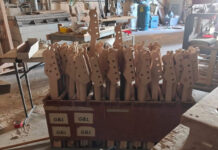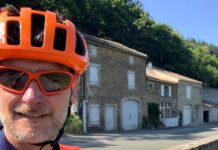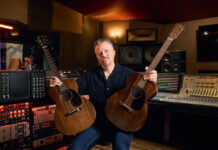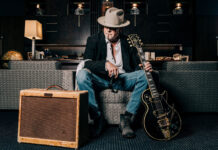
Interview: The Temperance Movement – Roots Manoeuvers
Losing two founding members could prove a fatal wound for lesser bands, but The Temperance Movement have come back stronger than ever. Thea de Gallier talks to guitarists Paul Sayer and Matt White and bassist Nick Fyffe about their chart-bothering revival…
Photography Eleanor Jane
It’s not unusual for bands to find themselves at a creative crossroads as they settle into their careers. The Temperance Movement are no exception; as the buzz around them began to grow after two albums, they found themselves navigating the American rock market, and being pulled in different directions by conflicting musical obligations.
It was January 2017, and the time had come to begin writing their third album. Guitarist Luke Potashnick and drummer Damon Wilson had left the band the year before, but replacements had been found quickly in the form of long-term friends Matt White, a session guitarist, and Simon Lea. The line-up change, though, wasn’t what stalled progress; it was the increasing pressure to write in a way that would appeal to their new US fans.
“The feeling of being unsure of what direction to go in wasn’t so much about the other guys leaving,” explains lead guitarist Paul Sayer. “We were touring in America a lot and we had a lot of options available to us, there was a lot of information going in and it wasn’t helping us make a decision about what to do next.
Getting radio play on different types of radio stations in America can lead you down a bit of a rabbit hole of thinking that you have to write songs for that kind of format, which didn’t sit very well with us. But at the time we were surrounded by a lot of people who were telling us that was the sensible thing to do. It wasn’t malicious, it wasn’t a cigar smoking executive, that was their job. It made us stagnate a bit because it didn’t feel natural.”
Shortly after Matt and Simon’s appointment, the band made the decision to stay true to their roots. “It was the moment that we realised that we needed to just make an album that we wanted to make, in the same way that we did right at the start,” says Paul. “That was kind of what the band had been built on. As soon as we realised that it happened really quickly and easily.”
Their epiphany led to the band parting ways with the execs trying to push them down a more commercial route. “We fired them all!” laughs Paul. “Now we’re on the same label everywhere excluding America. We had a specific record deal there and we’ve moved on from that – we’ve changed management as well.”A Deeper Shade
It was a strategy that paid off; A Deeper Cut peaked at number six on the UK Album Chart upon its release in February, which is no small feat for a rock band in a world where the charts are dominated by pop and electronic sounds.
Writing with a commercial audience in mind wouldn’t have worked for The Temperance Movement anyway; their writing methods sound almost slapdash when Matt describes how they began fleshing out ideas for A Deeper Cut.
“Every song is different, sometimes it’s just Phil writing at a piano, sometimes Paul brings in a fully-formed idea, or sometimes a bunch of us will go up to Glasgow and hammer stuff out. Or people sit on their own beavering away at home and present it to the group in a rehearsal. It all happens in different guises,” he says.
“There’s a little rehearsal room near where I live, and I like to go down there with a guitar and amp,” adds Paul. “I book it for four hours and I just play. Sometimes I’ll take a bit of gear that I haven’t used much, I might buy a few bits at the start of writing an album, because sonically they might inspire me. I might take a pedal with me that I’ve never used before and just mess around for a few hours and see if it inspires me to write something, starting from a sonic place first.”
The inspiration flows best when Paul’s using a piece of equipment he feels comfortable with, rather than choosing a guitar based only on its sound or what one of his heroes managed to do it. “What I’ve learned over years of buying things that my favourite guitar players have, and sounding nothing like them, is that it’s not really about that,” he says. “There are loads of guys that I love their playing: Blake Mills, Joey Landreth, Nels Cline. But unless you hit the strings with the same velocity that your favourite guitar player is, you’re not going to sound like them. Matt and I use the same amps and we sound totally different because we hit the guitar in a different way.
“It’s finding a guitar that you have a relationship with; you’ll be at your most creative if you’re really comfortable. I feel like when I’m playing, the last thing I should be thinking about is the guitar. It’s when I’m really noticing the instrument that I know it’s not right for me. Ideally you want to forget about it and just make music.”Cut Some Rug
Producer Sam Miller, who worked on the debut self-titled and on the second record, 2016’s White Bear, is back at the helm for A Deeper Cut. Making the decision to write from their hearts also made studio time at Monnow Valley – which boasts one of Europe’s biggest live rooms – remarkably simple; their studio rig was designed to reflect the live set-up, meaning they created a sound easily replicated on the road.
“We don’t want it to sound like we’re all in separate rooms switching sounds every section of a song, we want it to sound very organic so our live rig and studio rig are very closely related,” says Paul.
“We always record as a live band anyway,” adds Matt. “Obviously I wasn’t involved in the first two albums but from what I understand we always record as a live band, even Phil doing vocal takes at the same time [as the instrumentals]. Those things aren’t very separate to us, the line’s really blurred.”
The main difference is Paul’s preference for his ’59 Strat in the studio, while he prefers to use a ’69 Telecaster on stage. “I’ve found I’d rather have the consistency of one instrument for the gig, I’d rather sacrifice the differences in sounds between guitars and manipulate what I’ve got that than try and change guitars during the show,” he says. “I’ve got a couple of old Strats on tour because I used them in the studio.
On the album I end up using the Strat a lot, and I brought it away to work out whether I wanted to work it into the live show, but I’ve kind of gone back to my Tele. I like to try and keep it as simple as I can with the pedalboard as well, I’ve got an AnalogMan Sun Lion, which is a fuzz and a boost in one pedal, I’ve got a delay pedal for one song, a Leslie simulator for the other song, and a reverb pedal for another, and they’re fixed sounds. I like the challenge of less stuff.”
The Leslie simulator is there to satiate Paul’s love of the Leslie speaker, which ended up being used on the track Higher Than The Sun after bassist Nick Fyffe began “messing around” with one in another studio.
“Since we made this album I want to start bringing one on tour, but they won’t let me!” Paul laughs. While the cumbersome nature of a Leslie means it’s not a great tour mate, one studio trick they do replicate live is the straight-to-desk guitar sound. While the band joke that Matt “spent the first four days of the tour on his hands and knees” because of his more complex pedal set-up, he at least managed to find a way of recreating the sound live.Space Invader
As well as his rig of two Lazy J 20 amps – which Paul also uses – a ’63 Jazzmaster, his custom Probett Rocket and a Hahn 228 T-type, Matt also has a switching system which makes it easy for him to bounce between a traditional set-up and sending sounds direct to the desk.
“I didn’t want to compromise on the tones used on the album, but I didn’t want to complicate things, so I got it made into a switching system that’s really easy to use and sonically sounds better than the previous set. It’s the best of both worlds. I wanted to manipulate a DI sound as well – we used a little pedal on the album called a [JHS] Colour Box, so I’m sending that to front of house through the switching system. It’s kind of a revelation, but it’s really easy it gives the sound a few different colours.
Of course, certain atmospheric effects need to be tailored to the cavernous nature of a live room, and it’s the same with amp levels. “Live, you need to be aware of the space and what you can bring on the road, but also, in the studio it doesn’t matter if one amp is twice the volume of another one,” says Paul. “You just correct it in the mix, but you can’t do that live, there needs to be some level of consistency.”
Funnily enough, it was also venues – or rather, the fact that “it’s not like we can’t get 20 people to a big show”, as Paul puts it, that made the band realise that creating a sound true to them was a better option than trying to create music designed for a commercial audience. He’s right; their recent tour has seen them playing mid-level venues such as London’s 2,300-capacity Forum in Kentish Town, and Paul thinks the cliche that rock is dead or being relegated to history’s box of the uncool alongside leg warmers and flares ignores the fact that rock gigs don’t struggle to pull in fans.
“We’re playing great big gigs and we had a really good chart result with the album, so in amongst all that pressure we were feeling to change the music and make it bigger was the realisation that we need to appreciate what we had,” Paul admits. “We had to realise how good things are for the band, making the music that we do make. We were at risk of pulling it all apart in the process of trying to find something else. We had to sit and think, ‘actually what’s the problem?’”Top Of The Tree
At the time of writing, in mid-March 2018, only eight rock artists had a top 10 album this year – Fall Out Boy, Joe Bonamassa, Simple Minds, Don Broco, The Wombats, Franz Ferdinand, Embrace and Breeders. Some of those have a nostalgic appeal, while others – Fall Out Boy and Don Broco – flirt with pop and electro sounds.
On paper, The Temperance Movement are a band that shouldn’t be charting; they’re relatively new (they formed in 2011) and they make retro blues-rock that embraces and stays faithful to its influences rather than flirting with more modern and mainstream sounds. They could have become that band if the business-minded former label team had their way, but as Paul – and the number six chart position – points out, their current formula was working all along.
“We’ve talked about this a lot since we released the album,” Paul muses. “The mainstream music media is telling you that people making this kind of music are unfashionable, so you can’t be successful making that music, but there are a thousand people every night in a room telling you the opposite. It’s not that the music is unfashionable and nobody wants to hear it or see it, it’s just getting to those people without the help of the industry. Look at the 90s when you had Nirvana and Pearl Jam and Oasis and all those bands.
Those people haven’t been wiped off the face of the planet because Radio 2 has suddenly decided that type of music is uncool. They’re all there, it’s just maybe more difficult to find them. We don’t get passive audiences at shows who’ve been told to be a radio station or newspaper. We get the thousands of people who want to be there.”The post Interview: The Temperance Movement – Roots Manoeuvers appeared first on The Guitar Magazine.
Source: www.guitar-bass.net











